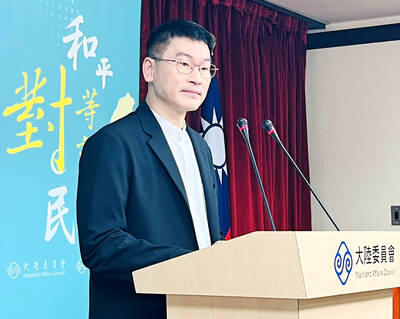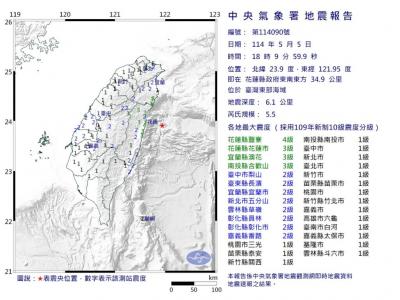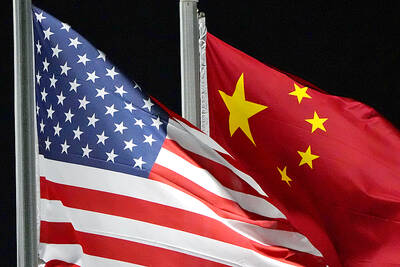The coining of a new phrase, "two sides of the Taiwan Strait, One China," to describe an old debate begs the question of whether the already term-laden cross-strait relations might truly benefit from this latest addition.
Coined in a communique forged by Chinese President Hu Jintao (胡錦濤) and People First Part (PFP) leader James Soong (宋楚瑜) on Thursday, the new phrase was added in parenthese after a reference to the so-called "1992 consensus."
But while the PFP billed the communique as a constructive redefinition of the "1992 consensus," it is not immediately clear what new ideas the term brings to the discussion.
While further explanation can be expected in the coming weeks, remarks by PFP representatives so far seem to suggest that despite the novel terminology, the "two sides of the Taiwan Strait, One China" notion does not stray ideologically far from its previous stance on the "1992 consensus."
In other words, both sides of the Taiwan Strait will adhere to the "one China" principle, but each is entitled to interpret "one China" as it sees fit.
The "1992 consensus" originates from verbal descriptions of the political situation between Taiwan and China following a meeting in Hong Kong in 1992 between negotiators from the semi-official Straits Exchange Foundation (SEF) and its Chinese counterpart, the Association for Relations Across the Taiwan Strait (ARATS). The exchange was retroactively dubbed the "1992 consensus" by former Mainland Affairs Council Chairman Su Chi (
While the communique is essentially Hu's nod of approval to the "two sides of the Taiwan Strait, One China" description of cross-strait ties, it remains to be seen what Beijing's interpretation of this term might be and whether any substantial agreement was reached between Soong and Hu.
It is appropriate to note, however, that just before heading in to the closed-door meeting during which the communique was inked, Hu remarked that "adherence to the `one China' principle embodying `1992 consensus' and opposition to Taiwanese independence are the political foundations for negotiations."
President Chen Shui-bian (
"What has changed in Beijing's stance? It looks like nothing has changed," Chen said during an interview Thursday, indicating that the "1992 consensus" was tantamount to the "one China" principle to Beijing.
The deadlock thus seems unaltered, but for the addition of new semantic input on describing what happened in 1992. Alexander Huang (
"Actually, the Chinese Communist Party [CCP] just reiterated long-held positions and interpretations of what happened in 1992," Huang said.
"The difference [marked by this] meeting is that both sides decided to reiterate in black and white, state again, and put it into a communique between the two parties. If there's anything new, it's that they put it in the communique to remind people that we have some kind of tacit agreement to disagree," Huang said.
The first point of the communique puts to paper the views which had been verbally expressed in 1992. It states that the SEF put forth at the time that "in the process of realizing national unification by joint efforts across the Strait, both sides are entitled to interpret the meaning of `one China' as they see fit, even though both sides insist on the `one China' principle."
Likewise, it reiterates the ARATS' expressed stance at the time that "both sides of the Taiwan Strait insist on the `one China' principle and strive for national unification, however, the meaning of `one China' shall not be involved in cross-Strait talks of a functional nature."
But, the documentation of past differences might serve only to give new life to old disagreements. If authorities in Taiwan and Beijing do not see eye to eye on the "1992 consensus" to begin with, can "two sides of the Taiwan Strait, one China" offer any new options for the resolution of differences? How constructive is a term that is a mutual recognition of a consensus that is in essence a recognition of political differences?
"The problem in the past 10 or so years was whether you could allow two interpretations of `one China.' And today, the problem is whether you allow two terminologies for the `1992 consensus,'" Huang said.
While the term "1992 consensus" had been fabricated to amplify the degree of agreement reached then and play down elements of disagreement, it is questionable whether a re-working of the consensus into that of "two sides of the Strait, one China" is not just a rehashing of old ideas and the reopening of an old can of worms.
"This might seem a step in the wrong direction for the pan-green political camps," Tamkang University's Institute of China Studies professor Chang Wu-Ueh (張五岳) said on Thursday, indicating that the independence-leaning pan-green camp might have been more willing to work with the "1992 consensus," than Soong's latest revision.
Huang also agreed that the "1992 consensus" might have been a "better sell" in Taiwan than the option spelled out by Soong.
"If I were in power, I would just stick with the 92 thing," Huang said, explaining that references to "one China" would be harder for the Taiwanese audience to stomach.
But while buffering long standing differences of "one China" with another layer of terminology in search of a resolution might seem like wringing a dry towel for water, it remains to be seen whether and how the administration might turn the situation into an opportunity for the future of cross-strait ties.

An essay competition jointly organized by a local writing society and a publisher affiliated with the Chinese Communist Party (CCP) might have contravened the Act Governing Relations Between the People of the Taiwan Area and the Mainland Area (臺灣地區與大陸地區人民關係條例), the Mainland Affairs Council (MAC) said on Thursday. “In this case, the partner organization is clearly an agency under the CCP’s Fujian Provincial Committee,” MAC Deputy Minister and spokesperson Liang Wen-chieh (梁文傑) said at a news briefing in Taipei. “It also involves bringing Taiwanese students to China with all-expenses-paid arrangements to attend award ceremonies and camps,” Liang said. Those two “characteristics” are typically sufficient

A magnitude 5.9 earthquake that struck about 33km off the coast of Hualien City was the "main shock" in a series of quakes in the area, with aftershocks expected over the next three days, the Central Weather Administration (CWA) said yesterday. Prior to the magnitude 5.9 quake shaking most of Taiwan at 6:53pm yesterday, six other earthquakes stronger than a magnitude of 4, starting with a magnitude 5.5 quake at 6:09pm, occurred in the area. CWA Seismological Center Director Wu Chien-fu (吳健富) confirmed that the quakes were all part of the same series and that the magnitude 5.5 temblor was

The brilliant blue waters, thick foliage and bucolic atmosphere on this seemingly idyllic archipelago deep in the Pacific Ocean belie the key role it now plays in a titanic geopolitical struggle. Palau is again on the front line as China, and the US and its allies prepare their forces in an intensifying contest for control over the Asia-Pacific region. The democratic nation of just 17,000 people hosts US-controlled airstrips and soon-to-be-completed radar installations that the US military describes as “critical” to monitoring vast swathes of water and airspace. It is also a key piece of the second island chain, a string of

The Central Weather Administration has issued a heat alert for southeastern Taiwan, warning of temperatures as high as 36°C today, while alerting some coastal areas of strong winds later in the day. Kaohsiung’s Neimen District (內門) and Pingtung County’s Neipu Township (內埔) are under an orange heat alert, which warns of temperatures as high as 36°C for three consecutive days, the CWA said, citing southwest winds. The heat would also extend to Tainan’s Nansi (楠西) and Yujing (玉井) districts, as well as Pingtung’s Gaoshu (高樹), Yanpu (鹽埔) and Majia (瑪家) townships, it said, forecasting highs of up to 36°C in those areas